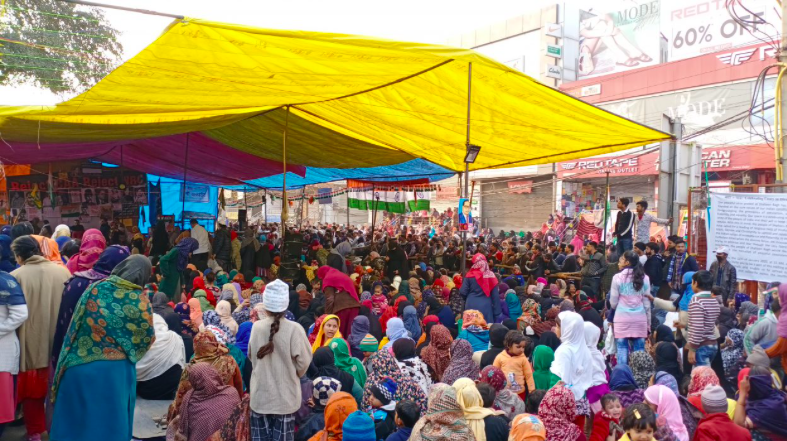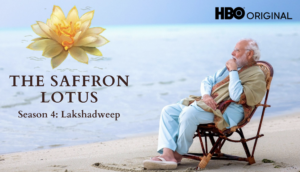

In this essay Ram Bhat looks at the connection between social media, disinformation and the propagation of hate speech.

Muslim women have been at the forefront of protest from Shaheen Bagh and Jamia Milia students in Delhi to the women participating in Bilal Bagh in Bangalore. Further, there have been widespread protests in many small towns and cities across the country where a wide cross-section of the public has participated in solidarity. Amidst this hope, the Delhi pogrom has shocked if not surprised. Targeted violence has become mediated to an unprecedented level with significant social implications. The mediation of violence is a complex phenomenon that needs not be reduced to technological determinism while remaining attentive to ways in which media and communication technologies become entangled in violence.
There have been multiple instances where disinformation prepares the ground for unleashing violence against vulnerable groups – especially Muslims, but also several instances of mediated violence have been reported against Dalits, Christians and Adivasis. There has also been too much hand wringing in mainstream discourse and in some sections of academia about the role of technology as if this were causing the violence.[1] On the 14 June 2017, Grenfell Towers caught fire in London – a fire in which 72 people died and another 70 were injured. It was a faulty piece of equipment (fridge-freezer) that sparked the fire, but it would be absurd if the entire explanation for the fire stopped at a faulty fridge-freezer. It was years of austerity politics (intentionally impoverishing whole sections of society while a tiny group became richer) that made Grenfell Towers inflammable. Similarly, it would be a mistake to assume that WhatsApp or Twitter or Tik-Tok is solely responsible for violence. Rather, the question should be why has society become inflammable? In Delhi of 1984, ordinary rubber tires and voter lists became deadly weapons.[2] There will always be enough ‘innovation’ to weaponize objects and technologies as long as societies are inflammable.
There are two broad points of significance when thinking about why some are ready to spread disinformation and hate against others: one is that we are ‘caste-structured’ societies and secondly, pre-colonial and colonial logics of oppression and control are encoded within contemporary forms of governance and sociality. On the point of caste-structured societies it has been argued: Hindutva as a communalism of vertically constructed communities is the dominant castes’ response to the emergence of the Indian version of ‘class struggle’. Setting up of the two religious monoliths [Hindu and Muslim] thus, is intended to cover up and suppress the growth of the class-like formations that have threatened the traditional solidarity time and again in modern history […] the real contest is between the economic and political interests of the lower caste-tribal-Muslim masses on the one hand and the traditional elite-the upper caste combine on the other.[3]
The recent electoral victory of the Bharatiya Janata Party (BJP) confirms that the dominant castes have regained control over the political system, eroding the incremental reforms achieved over the last few decades and, as Aloysius has argued, the discourse of ‘Hindu-Muslim conflict’ is concomitant with the consolidation of power (electoral and in other forms) by the dominant castes. As far as the encoding of pre-colonial and colonial logics within contemporary governance is concerned, everyday news about institutional behavior makes this more than clear (including the judiciary, the media and various other civil society institutions). Since media and communications is the focus of discussion, one can see that internet shutdowns, the recent ban on two television stations, the prohibition of news on radio are all done through the overarching architecture of the Indian Telegraph Act of 1885 and the Wireless Telegraphy Act 1933, both colonial legislations seeking to centralize control over communications in the aftermath of the 1857 revolts. In terms of communications, this architecture of control has remained largely intact even as wireless telephony has rapidly modernized Indian communicative ecology in the last two decades. Over four decades of increasing economic inequality, unemployment, the favoring of information-based industries to the neglect of other forms of livelihood, atomization of society and relentless policy focus on urban life have all contributed to make our societies inflammable. The consideration of mediated violence has to necessarily operate from within this historical context.
Coming to the mediation of violence more directly, social media platforms such as Facebook, Twitter, Instagram have completely failed to suppress hate speech. In spite of users complaining about hate speech and threats the companies have hidden behind the notion of free speech and neutrality to avoid action. It might not be a coincidence that the BJP is one of the biggest spenders/advertisers on social media – official spending alone coming close to 20 crore rupees (roughly 27,00,000 USD) in 2019. These platforms have the BJP as their biggest political client and unsurprisingly they would hesitate to clamp down on Hindutva hate speech given that many of the social media accounts inciting violence and hate are ‘proud to be followed by the PM.’ Without proactive intervention by the platforms and their owners, much of the expectation to manage mediated violence falls on conventional law and order systems – courts and the Police. A recent survey showed that half of the Indian Police feels that Muslims are more likely to commit crimes. Less said about these institutions the better.
Coming to peer to peer encrypted applications such as WhatsApp, I was involved in a research study conducted in 2019, and our team found that disinformation against Muslims was familiar to and believed by even those individuals who had no formal affiliations to political parties. This is because these individuals are part of multiple WhatsApp groups that have a continuous flow of disinformation. Such individuals continue to be part of these WhatsApp groups because the online group is an extension of offline networks based on caste, neighborhood, profession, friendship and so on. To participate in a group is to signify that one belongs to the offline network. Receiving messages and forwarding them are acts of sociality that individual users value highly. Many users told us that they forward messages so as to avoid giving the impression to their networks that they are not participating. Given that most of the WhatsApp users are members of multiple groups and receive and forward messages as signifiers of sociality, they experience fatigue. One effect of this fatigue is to disregard the message but focus on the forwarding. Users told us that they rarely see the full message but only the preview notification – just two lines that give a hint about what the message may be referring to. That is enough for users to forward without actually engaging with the content.
The BJP has invested in creating a sophisticated social infrastructure, where the ideological disinformation can be distributed (with enough flexibility and freedom to incorporate local references) down to the level of the polling booth. We found that WhatsApp groups are awash with disinformation especially against Muslims through local and national references. These messages are not concentrated but rather diffused in a flow of social media messages. Beginning with ‘good morning’ greetings in the morning, to random messages about festivals, health related issues, religious/spiritual matters, local news, the hate speech and disinformation is casually integrated amidst all the other messages. We found there exists rampant usage of unauthorized versions of WhatsApp such as WhatsApp GB, WhatsApp Plus where the affordances are not restricted as they are with the official version. With these unauthorized versions, one can form larger groups, has no restrictions on forwarding messages and so on. Older users told us that the credibility of the sender matters more than the credibility of the message. Often this meant that disinformation coming from ‘trusted’ sources was shared without any skepticism or effort to check veracity. Cutting across different kinds of users with different motivations, disinformation received on WhatsApp is then re-activated/confirmed offline at various other moments of social life – including interpersonal conversations, on mainstream television (especially news but also soap dramas, comedy shows), music, quasi-spiritual or religious meetings. The circulation of disinformation on WhatsApp, Tik-Tok and other social media platforms is but one moment (amongst many others) of a very perverse project – providing the ‘empty homogenous time’ of digital social media through which a Hindu community is imagined.[4]
Only time will tell whether this perverse project succeeds or not. In the electoral domain, however, the tendency is quite clear. The lynching of Muslims and Dalits by Hindutva vigilantes has become a ‘shortcut’ to political stardom. It is often assumed that the BJP has directly encouraged lynchings, but I would argue that it is unnecessary to have a direct monetary (or any other) link – the lynchings and the violence is happening in a ‘bottom up’ rather than top down way. There are already enough signifiers in national politics for this bottom up process. The success of the BJP’s explicit and mediated Hindutva politics starting from Advani’s anti-Mandal and anti-Muslim politics in the early 1990s[5] has started to ‘inspire’ many others. The steep ascent of Ajay Bisht’s career (along with other ‘rising stars’ such as Sangeet Som in Uttar Pradesh, Pragya Thakur in Madhya Pradesh, Anant Hegde and Tejasvi Surya in Karnataka, Giriraj Singh in Bihar to name a few) has given a clear path for many that the old days of rising up through the cadre, a la Modi, is over. The new way to rise up in politics is to be noticed in the public eye. The fastest, easiest and safest way to become a well-known name, as many have discovered, is to harm vulnerable Muslims under the excuse of any number of well-known tropes – love jihad to cow protection. Hari Om Sisodia lynched Mohammad Akhlaq in 2015 and Shambhu Lal Regar hacked Afrazul to death in 2017 – both have got tickets to contest elections from the Uttar Pradesh Navnirman Sena. Naveen Dalal who shot at Umar Khalid got a ticket from Shiv Sena to contest elections in Haryana. This is also why politicians like Jayant Sinha not only garlanded the men who murdered Alimuddin Ansari in 2017, but also paid their legal fees. There seems to be little doubt that Gopal Sharma, the young man who recently shot at Jamia protestors has a bright political career ahead of him. Rather than the BJP getting involved in every act of violence directly, the electoral success of the BJP’s politics of hate is quickly giving the basis for fascism as a mass movement.[6]
Many civil society institutions are investing in training communities to identify fake messages. The training can be done by focusing on the technical aspects – does the video have too many cuts? Can the user perform a reverse image search on Google? Can the user check fact-checking websites such as Alt-News or Boom Live or any of the various fact-checking initiatives that have come out of the woodwork since companies such as Facebook are beginning to support fact-checkers to battle fake news? There is no doubt that fact-checking initiatives have done a wonderful job of clarifying the facts, but the problem is that many individuals and groups have already made up their minds regardless of the facts. The assumption that users share disinformation simply because they didn’t know it was disinformation seems a bit naive. Especially during ‘charged occasions’ (such as the Pulwama attacks and the ensuing strikes in Balakot, the general elections or state elections), users said that ‘the facts’ mattered less than standing up for the nation or doing the right thing. The point of social media disinformation is to make every message of hatred a charged occasion. The ‘charge’ doesn’t need to come from an external context but is increasingly embedded within the message itself. Rather than ignorance or lack of technical literacy, we find that users share disinformation because: a) it is part of a larger perverse project of creating an imagined Hindu community; b) it has become a crucial element for many jobless, frustrated and angry young men to rise to political stardom; and c) because it confirms the prejudices, anxieties, fears and desires of those who currently benefit from a caste-structured society. The utopia of rational-critical citizens[7] seeking objective facts must be replaced with a more sober and realistic assessment of mediation as a struggle for power – over who is being represented by whom, in what ways, and with what consequences? The politics of representation ranges from the banal messages of social media to rewriting history in textbooks. I don’t mean that the politics of representation is merely about inclusion, diversity, or about increasing connectivity and access to media. I mean that the understanding of the ‘political’ has to a large extent become inextricably linked to who and what is visible.[8] This is not necessarily a new phenomenon, neither is it always a problematic linkage. For example, Dr. Ambedkar and his colleagues struggled in the early 20th Century (especially from 1911 to 1932 – over three censuses) precisely to render the population of Dalits visible.[9]
This is not a diatribe against social media either. After all, most of the mainstream television, print media and public broadcasting service are overt about their support for the BJP. On the other hand, user-generated content distributed on social media has provided crucial evidence of pogroms and violence. Many new efforts rooted in anti-caste perspectives depend on social media to develop their audiences with minimal capital and operational expenditure. While encouraging such efforts, progressive users and social media companies can push back against the fascism-as-mass-movement. It will not be easy nor are there any quick fix solutions. As I have mentioned in the beginning, the mediation of violence is intimately linked to the larger problem of society becoming inflammable. While the process of firefighting is a longer and slower exercise, there are immediate steps that can be taken by technology companies to prevent loss of life in the short term. Social media companies would do well to make their stance clear on whether they support human rights and are against hate speech; and if so, then put in place some mechanisms and processes explicitly designed to protect vulnerable groups and invest in long term processes to develop critical media literacy so that oppressed and vulnerable groups can participate equitably in the politics of representation.
Ram Bhat is co-founder of Maraa, a media and arts collective in Bangalore and a PhD candidate in the department of Media and Communications, London School of Economics and Political Science.
[1] The obverse of this is the celebration of technology – for example in the construction of ‘Twitter or Facebook revolutions’ in the Middle East.
[2] Sanjay Suri, 1984, the Anti-Sikh Violence and After (Noida, U.P: Harper Collins, 2015).
[3] G. Aloysius, “Trajectory of Hindutva,” Economic and Political Weekly 29, no. 24 (1994): 1452.
[4] Benedict Anderson, Imagined Communities : Reflections on the Origin and Spread of Nationalism (London: Verso, 1983), 26; Hannah Arendt and Walter Benjamin, Illuminations (New York: Schocken Books, 1986).
[5] Purnima Mankekar, Screening Culture, Viewing Politics : An Ethnography of Television, Womanhood, and Nation in Postcolonial India (Durham, N.C.: Duke University Press, 1999); Arvind Rajagopal, Politics after Television Religious Nationalism and the Reshaping of the Indian Public (Cambridge: Cambridge University Press, 2001).
[6] Arthur Rosenberg, “Fascism as a Mass-Movement,” Historical Materialism 20, no. 1 (2012): 144–189.
[7] Thomas Bürger, Frederick Lawrence, and Jürgen Habermas, The Structural Transformation of the Public Sphere : An Inquiry into a Category of Bourgeois Society (Cambridge : Polity, 1992).
[8] Jacques Rancière, The Politics of Aesthetics : The Distribution of the Sensible, Pbk. ed. (London ; New York : Continuum, 2006).
[9] Bhimrao Ambedkar, “From Millions to Fractions,” in Dr. Babasaheb Ambedkar: Writings and Speeches Vol. 5 (Delhi: Education Department, Government of Maharashtra, 1989), 229–246.





